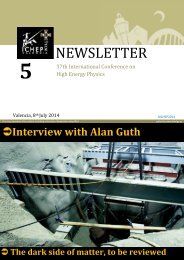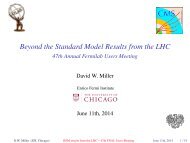PW_mar13_sample_issue
PW_mar13_sample_issue
PW_mar13_sample_issue
You also want an ePaper? Increase the reach of your titles
YUMPU automatically turns print PDFs into web optimized ePapers that Google loves.
Comment: Robert P Crease<br />
that lay beyond science itself. These popularizations<br />
encountered an enthusiastic<br />
audience. Artists, novelists, poets and<br />
journalists were fascinated by the non-<br />
Newtonian features of quantum mechanics,<br />
including discontinuity, uncertainty,<br />
unpredictability, and differences across<br />
scales and areas where scientists could<br />
not take themselves out of measurements.<br />
Quantum terms and concepts – including<br />
quantum leap, uncertainty principle,<br />
complementarity, Schrödinger’s cat and<br />
parallel worlds – eventually appeared in<br />
everyday language in sparkling prose and<br />
flamboyant metaphors.<br />
But has the cultural impact of quantum<br />
mechanics been simply to supply us with a<br />
storehouse of unusual, vivid and sometimes<br />
pretentious or even loopy images? Or has<br />
the cumulative effect been more serious,<br />
and reshaped how even non-scientists view<br />
the world?<br />
To some extent, the quantum’s impact<br />
on artists, writers and philosophers was<br />
that it helped free themselves from their<br />
own Newtonian-inspired misconceptions.<br />
A year or two after the discovery of the<br />
uncertainty principle in 1927, for instance,<br />
the writer D H Lawrence penned the following<br />
poem fragment.<br />
I like relativity and quantum theories<br />
Because I don’t understand them.<br />
And they make me feel as if space shifted<br />
About like a swan that can’t settle,<br />
Refusing to sit still and be measured;<br />
And as if the atom were an impulsive thing<br />
Always changing its mind.<br />
Lawrence’s playfully negative remarks<br />
may suggest that his attraction is superficial:<br />
he likes relativity and quantum theories<br />
because they connect better with his<br />
experiences of the world as quixotic and<br />
immeasurable. A similar sentiment was<br />
expressed by the Austrian-Mexican artist<br />
Wolfgang Paalen in 1942 when he wrote<br />
excitedly that quantum mechanics heralds<br />
“a new order in which science will no longer<br />
pretend to a truth more absolute than that<br />
of poetry”. The outcome, he continued, will<br />
be to legitimize the value of the humanities,<br />
and “science will understand the value of<br />
art as complementary to her own”.<br />
Meanwhile, in 1958 when the New York<br />
University philosopher William Barrett<br />
reviewed 20th century scientific developments,<br />
including quantum mechanics, he<br />
concluded that they paint an image of man<br />
“that bears a new, stark, more nearly naked,<br />
and more questionable aspect”. We have<br />
been forced to confront our “solitary and<br />
groundless condition” not only through<br />
existentialist philosophy but also via science<br />
itself, which has triggered “a denudation,<br />
a stripping down, of this being who has<br />
now to confront himself at the centre of all<br />
his horizons”.<br />
physicsworld.com<br />
Popular physics A couple walks past “Quantum Field-X3”, an installation by Japanese artist Hiro Yamagata,<br />
outside the Guggenheim Museum in Bilbao, Spain.<br />
Such remarks suggest that humanists<br />
embraced quantum mechanics because<br />
they experienced the Newtonian universe<br />
as a cold and constricting place in which<br />
they felt defensive and marginalized – with<br />
the news of the strangeness of the quantum<br />
domain coming almost as a relief. But if this<br />
is the only reason humanists found developments<br />
of the quantum world liberating, it<br />
was surely their own doing, for they were<br />
relying far too seriously on science to begin<br />
with in understanding their own experience.<br />
A new humanism<br />
In 1967 the critic and novelist John Updike<br />
wrote a brief reflection on the photographs<br />
and amateur films taken in Dealey Plaza<br />
in Dallas, Texas on 22 November 1963, in<br />
the few momentous seconds when President<br />
John F Kennedy’s motorcade drove<br />
through and he was hit by an assassin’s<br />
bullets. The more closely and carefully the<br />
frames were examined, Updike noted, the<br />
less sense the things in them made. Who<br />
was the “umbrella man” sporting an open<br />
umbrella despite it being a sunny day? Who<br />
was the “tan-coated man” who first runs<br />
away, then is seen in “a gray Rambler driven<br />
by a Negro?” What about the blurry figure<br />
in the window next to the one from which<br />
the shots were fired? Were these innocent<br />
bystanders or part of a conspiracy?<br />
“We wonder,” Updike wrote, “whether<br />
a genuine mystery is being concealed here<br />
26 Physics World March 2013<br />
Reuters/Vincent West








